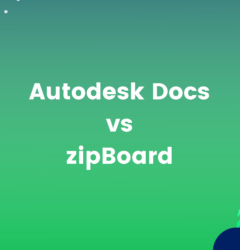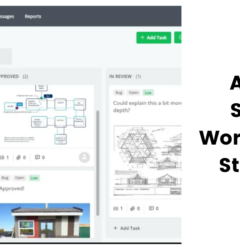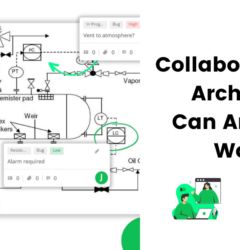How to Optimize Communication and Collaboration in Construction Administration
31 May
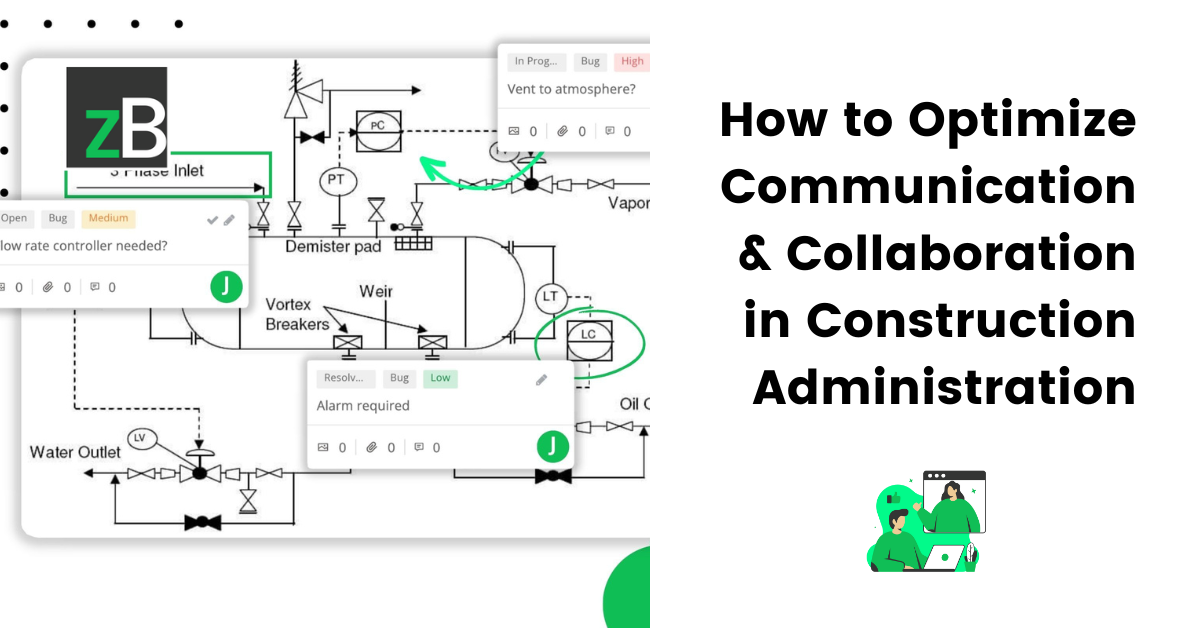
Table of Contents
ToggleResearch by Construction Navigant and PlanGrid show that, 9% of a project’s combined cost stems from rework, with 52% of that rework being attributed to miscommunication and poor project data. Additionally, nearly 35% of project time is lost due to ineffective activities, resulting in $280 billion in annual rework expenses. For these reasons, streamlining communication and collaboration is relevant in construction administration (CA).
What is Construction Administration?
Construction administration, also known as construction contract administration, is a crucial phase that occurs from pre-construction through to construction and inspection. Its primary objective is to ensure the final product adheres to the plans and regulations stipulated in the contract. During this stage, the architect assumes a central role, managing submittal packages, change orders, building code compliance, subcontractor oversight, and more.
Beyond safeguarding the architect’s design intent, CA ensures the project aligns with the agreed-upon contract. Architects involved in CA meticulously review submittal packages and inspection reports to verify that materials and construction methods comply with the plans. They act as a go-between for the owner and contractor, managing costs and ensuring the project stays within schedule and budget. Ultimately, CA ensures the project is built to the high-quality standards outlined in the client-signed contract.
While construction administration plays a crucial role in ensuring project success, fostering clear communication and collaboration throughout the process can be daunting — particularly during the pre-construction review of submittals and drawings. These challenges include task tracking, lack of visibility, stakeholder coordination, etc.
It’s noteworthy that miscommunication between project managers, field workers, and other stakeholders can snowball into costly mistakes, quality issues, conflicts, lost profits, project delays, and reputational damage. Without a central repository for clear and consistent documentation, misunderstandings can easily arise, further straining communication and hindering project progress.
Consequently, these implications underscore the need for optimized communication and collaboration in construction administration. This guide provides the information and tools you need to streamline the process and ensure desired outcomes.
Benefits of Optimized Communication and Collaboration in Construction Administration
Reduced Rework and Errors
Clear communication ensures everyone involved understands the design intent from the outset. This minimizes misunderstandings and missed details, leading to fewer errors and a significant reduction in costly rework.
Imagine a project where architects clearly communicate specifications for window placements. When this occurs and contractors are fully informed, they can avoid installing windows incorrectly, saving time and money on rectifying the mistake.
About the data in PlanGrid’s Construction Disconnected report which stated that “globally, an average of 52% (representing a cost of $280 Billion) of rework is caused by miscommunication and poor project data”, the Editorial Team at Matterport asserted that “If your team is able to quickly communicate any project updates, whether with field teams or design teams, it’s less likely bad data or miscommunications will hinder your progress”.
Learn how zipBoard reduces rework
Book DemoStreamlined Processes and Faster Decision-Making
Not only does effective communication reduce rework and delays. It allows for quicker decision-making, keeping the project on track and avoiding costly budget and schedule overruns.
This is because when information flows smoothly, project reviews become faster and more efficient. Owing to this, delays caused by waiting for clarification or chasing down missing details are minimized.
Streamline your construction projects with zipBoard
Start Your Free Trial TodayImproved Project Delivery and Adherence to Deadlines
Clear communication and collaboration empower all stakeholders to work together seamlessly. This synchronized workflow ensures everyone involved has the latest information and can contribute effectively. When the project progresses smoothly, it minimizes delays and ensures timely delivery within the established deadlines.
Reduces Risks
When clear communication is prioritized, critical safety information is readily shared and understood by all parties. This proactive approach reduces the risk of accidents and costly safety violations. Additionally, timely communication of design changes or potential issues allows for prompt risk mitigation strategies, minimizing the chance of problems snowballing into major setbacks.
More so, comprehensive liability insurance for electricians – provided by ContractorNerd – can safeguard your projects from financial liabilities arising from unforeseen incidents. This insurance coverage complements efficient communication practices, allowing your team to focus on project success without the worry of unexpected setbacks.
Recommended Reading
https://zipboard.co/blog/aec/risk-management-in-architecture-how-to-mitigate-risks-and-protect-your-firm/
Builds Trust
Open communication fosters trust and transparency among project stakeholders. Team members feel comfortable raising concerns, sharing ideas, and working together to solve problems. This collaborative environment strengthens relationships and promotes a sense of shared purpose, ultimately leading to a more successful project outcome.
Apart from building trust among architects, engineers, and contractors, effective communication and collaboration also strengthens the relation between the team and clients. And you know, happy clients would always be happy to return or refer you.
6 Communication and Collaboration Challenges in CA
1. Lack of Clear Communication Protocols: Without established guidelines for information sharing, crucial details can easily be lost or misinterpreted. This can lead to costly mistakes during project execution.
2. Difficulty Centralizing and Tracking Project Documents: Juggling many documents like submittals, RFIs, and drawings across various stakeholders is daunting. This decentralized approach can lead to lost or misplaced documents, hindering project progress.
3. Inefficient Communication Channels: Reliance on outdated communication methods like phone calls and emails can lead to delays and misunderstandings. These methods often lack a clear audit trail, making it difficult to track conversations and decisions.
4. Limited Real-Time Collaboration During Pre-construction: Inefficient processes for sharing and revising blueprints, designs, and other project documents during pre-construction can lead to costly rework later. It’s worth noting that communication and collaboration aren’t always about the tools you use but also about the processes and workflows you set up to ensure real-time collaboration.
5. Difficulty Maintaining Transparency and Accountability: Holding all stakeholders accountable can be challenging with information scattered across different locations and communication channels. And a lack of transparency can breed mistrust and hinder problem-solving efforts.
6. Manual Processes and Technological Gaps: Firms that rely on paper-based processes for document management and communication are prone to construction documentation errors and inefficiencies. These manual methods are time-consuming and tedious and limit real-time collaboration.
7. Coordinating Multiple Stakeholders with Different Technological Proficiencies: Construction projects involve a diverse group of stakeholders with varying levels of tech-savviness. For instance, clients may not have the same access or understanding of advanced technology as your team. This disparity can create communication barriers and hinder information sharing.
8. Scheduling Challenges: Assigning tasks and creating realistic project schedules can be difficult due to unforeseen delays and changes. Additionally, traditional methods often lack the nimbleness to adapt to these unforeseen circumstances.
How to Optimize Communication and Collaboration in Construction Administration
Establish Clear Communication Protocols
The foundation for effective communication lies in establishing clear protocols. This includes defining communication frequency, channels (e.g., daily reports, weekly meetings), and platforms (like Microsoft Teams, email, and, collaboration tools like zipBoard, etc) for different types of information.
When you outline a clear process for submittal review, including deadlines for responses and revisions, it ensures timely feedback and keeps the project moving forward.
https://zipboard.co/blog/aec/how-to-set-up-a-shop-drawing-review-process-a-comprehensive-guide-with-free-template/
To keep things organized, create a communication plan and include all your protocols in that document. This is because “Sharing information clearly and consistently requires a plan. Without it, things become messy and stakeholders can become confused and unhappy.” (Project Manager)
It’s worth noting that this plan and protocols can be established at various levels within your firm, including relevant stakeholders, such as different departments or teams. For example, for project-level communication plans, the architecture project manager takes the lead, while HR spearheads organizational-level plans.
https://zipboard.co/blog/aec/how-to-ensure-effective-collaboration-in-construction-document-reviews/
Use Technology
Investing in modern technology can give you a single source of truth for all documents and project information. This will help streamline construction administration and keep designers, contractors, owners, and clients on the same page throughout the project. More so, using technology can help streamline your workflow and improve efficiency.
Some key tools to invest in include project management software (Procore and Project Manager), document management systems, project information management software (Newforma and Tonic DM), communication platforms (Microsoft Teams, Slack), and construction collaboration tools like zipBoard and Autodesk Docs.
It’s worth noting that…
It’s a little bit about the technology and a little bit about how structured the workflows are presented. – Vivin Hedge, GP and founding partner of Zacua Ventures, in the Bricks and Bytes Podcast
[Case Study]
How zipBoard helped an actual construction firm streamline submittals and reduce errors
Read the Case StudyFoster a Collaborative Culture
Building a strong foundation for communication and collaboration in construction administration goes beyond just technology. Fostering a collaborative culture is key to successful communication and collaboration. This requires encouraging open communication and active listening within the project team – through the appropriate channels and platforms.
When team members feel comfortable voicing concerns and asking questions without judgment, and actively listen to ensure everyone feels heard and understood, trust is built and issues can be identified and resolved early on.
Build a Collaborative Mindset
Shifting towards a collaborative mindset is a crucial step in overcoming communication barriers during CA. As Vivin Hedge, GP and founding partner of Zacua Ventures, stated in the Bricks and Bytes Podcast, a lack of trust in the system can hinder collaboration. Hence, breaking down barriers, which ensure transparency, can improve collaboration within the team and build trust.
How Technology Transforms Collaboration in Construction Administration
Construction administration is a complex process involving numerous stakeholders, from architects and engineers to contractors and subcontractors.
Effective communication and collaboration are crucial for the successful completion of any construction project, ensuring that everyone is on the same page, deadlines are met, and potential issues are addressed proactively.
Technology has emerged as a powerful enabler, transforming the way construction administration teams collaborate. Here are some key ways:
Cloud-Based Document Management
Cloud-based document management software like zipBoard enable construction teams to upload, access, and manage project files from anywhere.
By centralizing essential documents such as blueprints, contracts, and schedules, these tools ensure that all stakeholders work from the latest version of a file. Teams no longer need to worry about misplacing critical documents or working from outdated information.
Additionally, real-time updates and seamless sharing capabilities keep everyone aligned, reducing delays caused by missing files or miscommunication. This streamlined access to information boosts efficiency and minimizes project disruptions.
Real-Time Communication Tools
Instant messaging (Slack), video conferencing (MS Teams, Zoom), and shared dashboards have transformed how construction teams communicate. These tools allow teams to share updates, clarify project details, and make decisions quickly, even when team members are working remotely or across different job sites.
Virtual meetings and on-the-go messaging keep projects moving forward without delays.
Digital PDF Markup & Annotation
Gone are the days of printing and marking up physical documents. With digital PDF annotation tools like zipBoard, teams can directly mark up blueprints, drawings, and site photos within construction (document) management platforms.
This reduces communication errors, speeds up the construction document review process, and ensures that feedback is clear and actionable.
[Webinar]
Streamline Your Construction Document Review Process
Watch the Recording Project Management Software
Construction project management software provides construction teams with the tools they need to plan, coordinate, and execute projects effectively. These platforms allow teams to create project timelines, assign tasks, and monitor real-time progress.
While document management tools offer some project tracking capabilities, construction management software takes collaboration to the next level by providing the tools required to manage and collaborate on construction projects in one place:
- Invoicing & Billing: Simplify financial tracking by generating and managing invoices for clients and subcontractors.
- Resource Allocation: Assign resources like labor, equipment, and materials to specific tasks for better utilization.
- Risk Management: Identify potential risks and create mitigation strategies directly within the software.
- Compliance Tracking: Ensure that all regulatory and safety requirements are met with built-in compliance tools.
Data-Driven Insights
Modern construction platforms generate performance reports and project analytics, enabling better decision-making. Teams can track project timelines, budgets, and task completion rates, allowing proactive adjustments to avoid delays or cost overruns.
Insights gained from these reports contribute to more efficient project planning and improved overall productivity.
Benefits of Using Technology for Collaboration
- Improved Communication and Coordination: Streamline communication channels, enhance information sharing, and ensure that everyone is on the same page.
- Increased Efficiency and Productivity: Automate repetitive tasks, reduce paperwork, and accelerate decision-making.
- Enhanced Project Visibility: Gain real-time insights into project progress, identify potential risks, and proactively address issues.
- Improved Collaboration: Foster better collaboration among team members, subcontractors, and other stakeholders.
- Enhanced Project Quality: Minimize errors, improve accuracy, and ensure that the project is delivered on time and within budget.
How to Streamline Communication and Collaboration In Construction Administration with zipBoard
Optimizing communication and collaboration throughout construction administration is essential for project success. Traditional methods, like email and paper trails, can be cumbersome and lead to information silos. zipBoard, a document management and collaboration platform for AEC teams, addresses these challenges by offering a centralized hub for seamless communication and collaboration throughout all stages of CA.
Here’s a closer look at how zipBoard streamlines communication and collaboration within key functions of construction administration:
zipBoard’s project dashboard provides a clear overview of all submittal packages, allowing architects or any stakeholder serving as a construction administrator to track construction documents and manage project status.
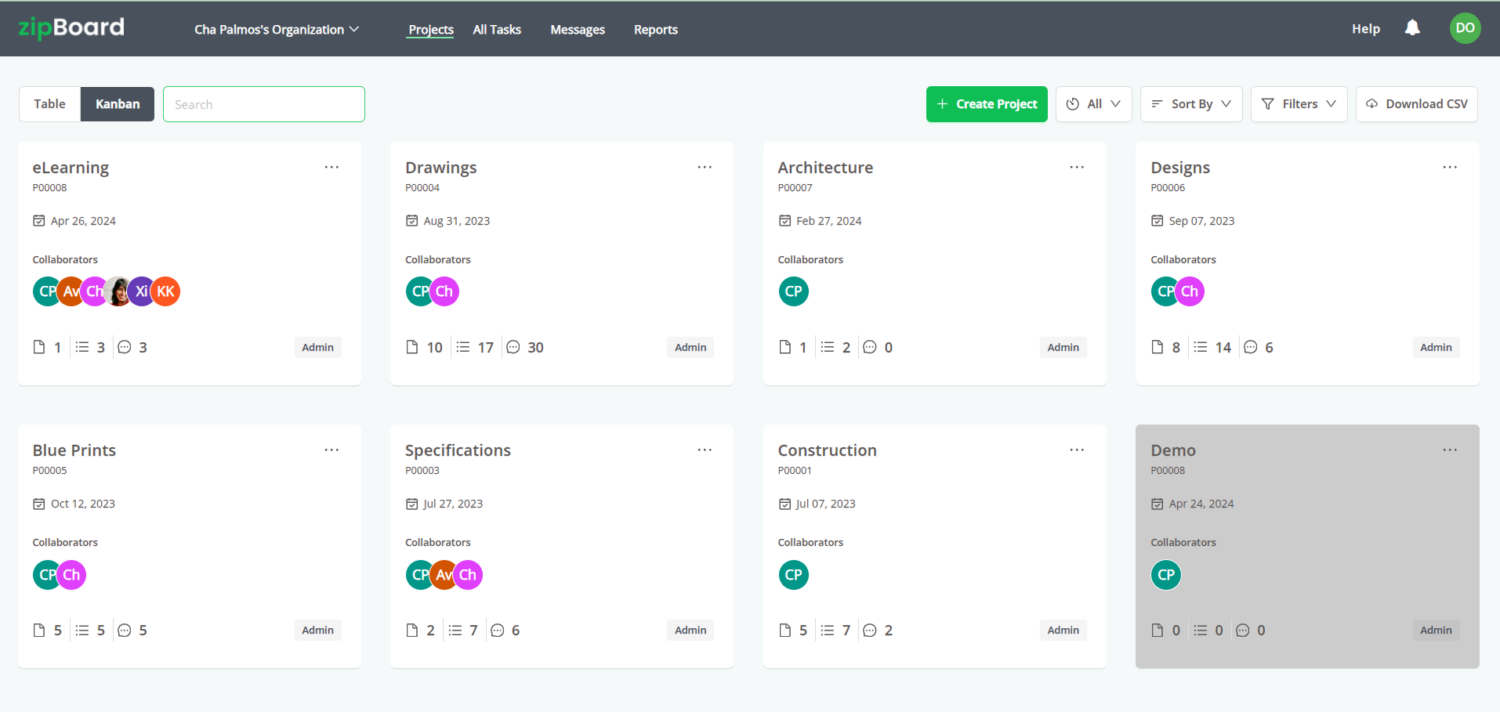
The good thing is that contractors do not need to manually upload submittals in the app. Through zipBoard’s API integrations, you can seamlessly integrate zipBoard with your cloud store or document management system and collaborate on drawings and submittals with ease – without having to move documents from one place to another. This also helps save time.
Additionally, zipBoard’s PDF markup tools enable architects to provide clear and concise feedback directly on drawings or specifications. They can highlight areas requiring attention, add comments, and tag specific individuals for their input.
More so the phases feature in zipBoard acts as a version control system that ensures everyone is working with the latest version. These phases enable you to create customizable workflows in Kanban view for your approval process. This gives every stakeholder a clearer view of document progress, ensures they move smoothly from one stage to another, and keeps everyone on the same page, thereby minimizing errors.
Recommended Reading
https://zipboard.co/blog/aec/submittal-workflow-automation/
Real-Time Communication and Collaboration
Being a cloud-based collaboration software, zipBoard allows for seamless real-time document collaboration among all project stakeholders, regardless of location. Architects, engineers, contractors, and even clients can access and update project documents simultaneously, eliminating delays and version control issues. The best part? There is no per-user licensing with zipBoard so you can bring unlimited stakeholders on board! Learn more here.
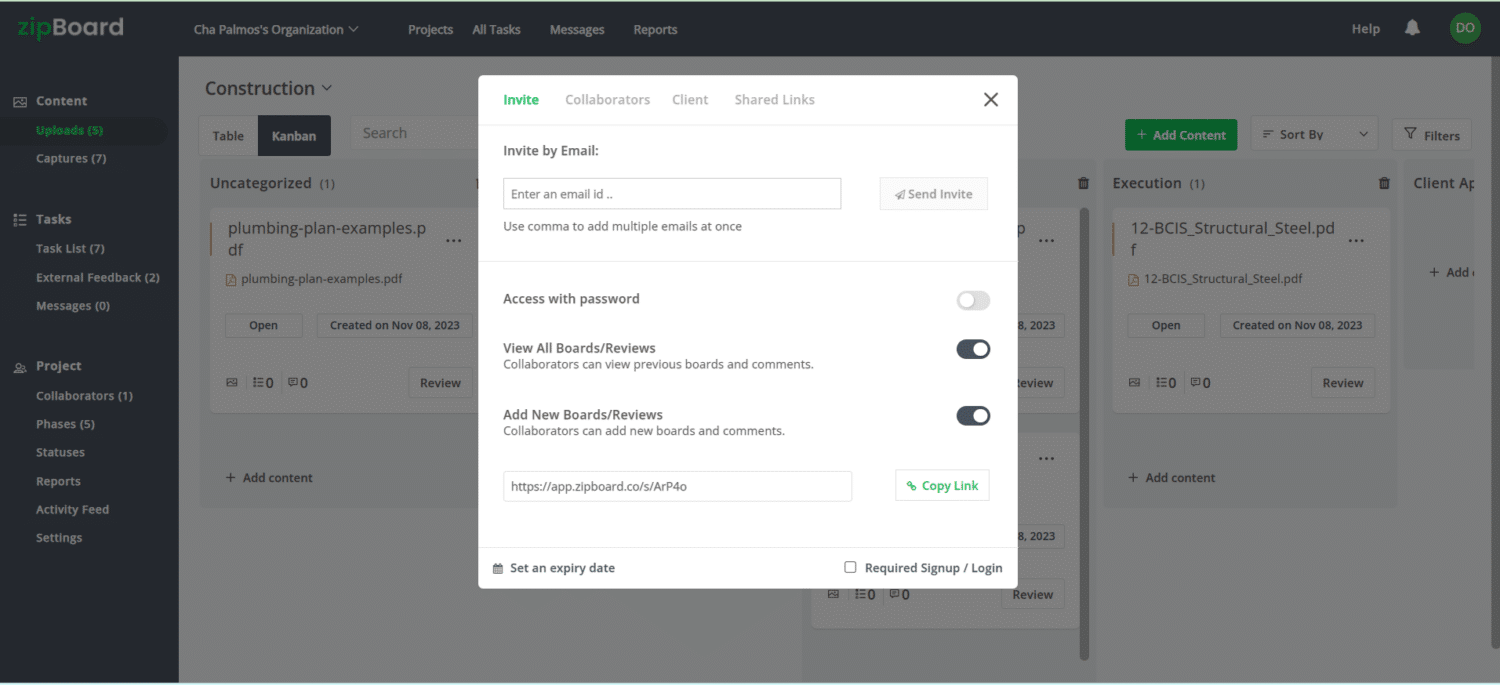
Also, because zipBoard seamlessly integrates with your existing Document Management System (DMS) or cloud storage, you don’t have to juggle multiple tools or give feedback in different places. This eliminates the risk of project information getting lost or not being seen by stakeholders promptly.
Furthermore, the notifications, messaging, and announcement features in zipBoard facilitate instant communication and ensure all relevant parties are notified for real-time discussions on projects.
Enhanced Transparency with Document Tracking and Version Control
By integrating with your cloud store or DMS, zipBoard provides a central repository for all project documents, drawings, and specifications. This eliminates the need to search through emails or physical folders, saving time and ensuring everyone has access to the latest information.
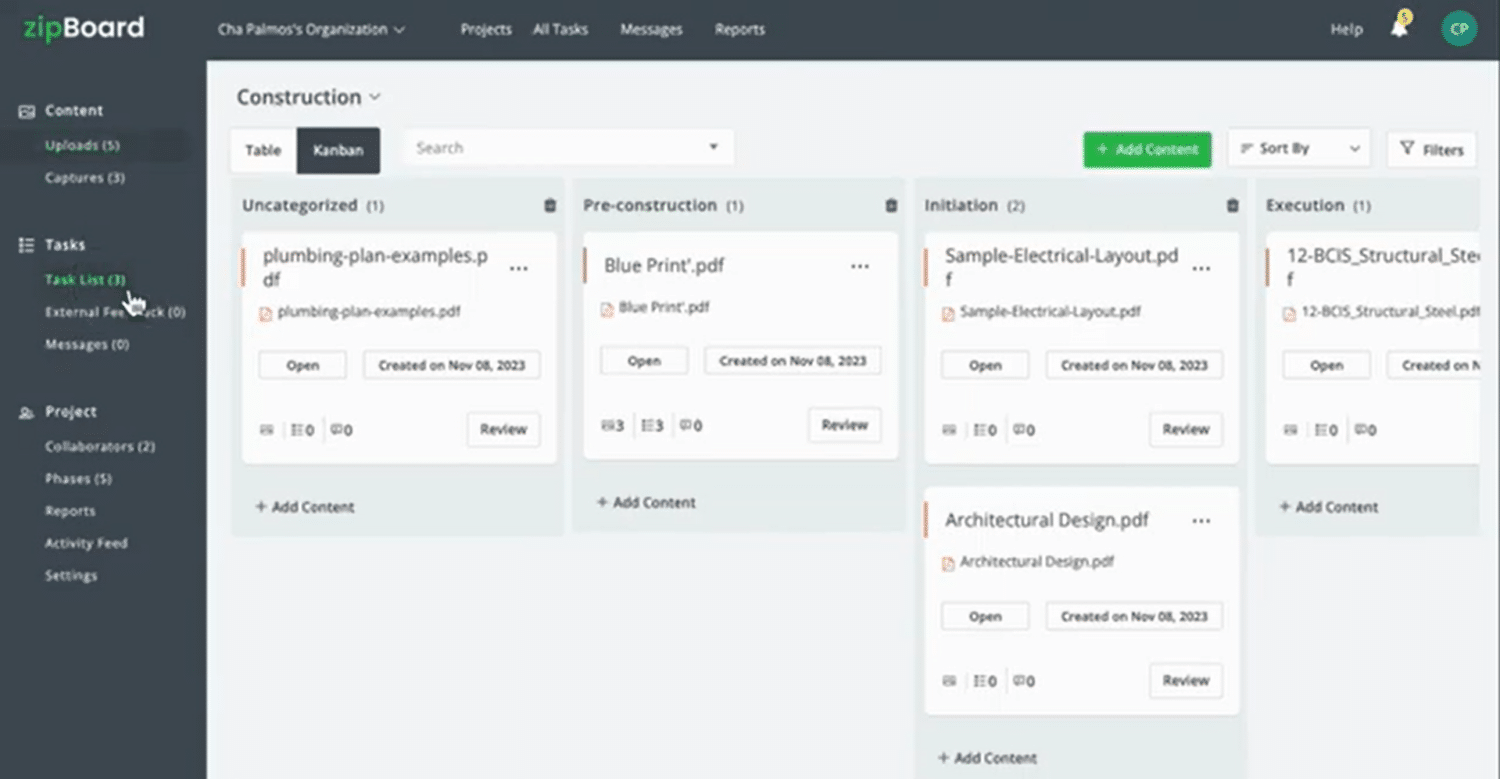
Additionally, setting up a workflow in zipBoard using phases ensures everyone has access to the latest information, eliminating confusion caused by outdated information. Again, construction administrators using zipBoard have access to multiple project views, including Kanban boards and tables, which allow them to visualize project progress and identify potential issues with ease.
Streamlined Task Management
The built-in task manager in zipBoard enables construction administrators and stakeholders to manage their entire task list in one place. No need to juggle multiple tools or spreadsheets.
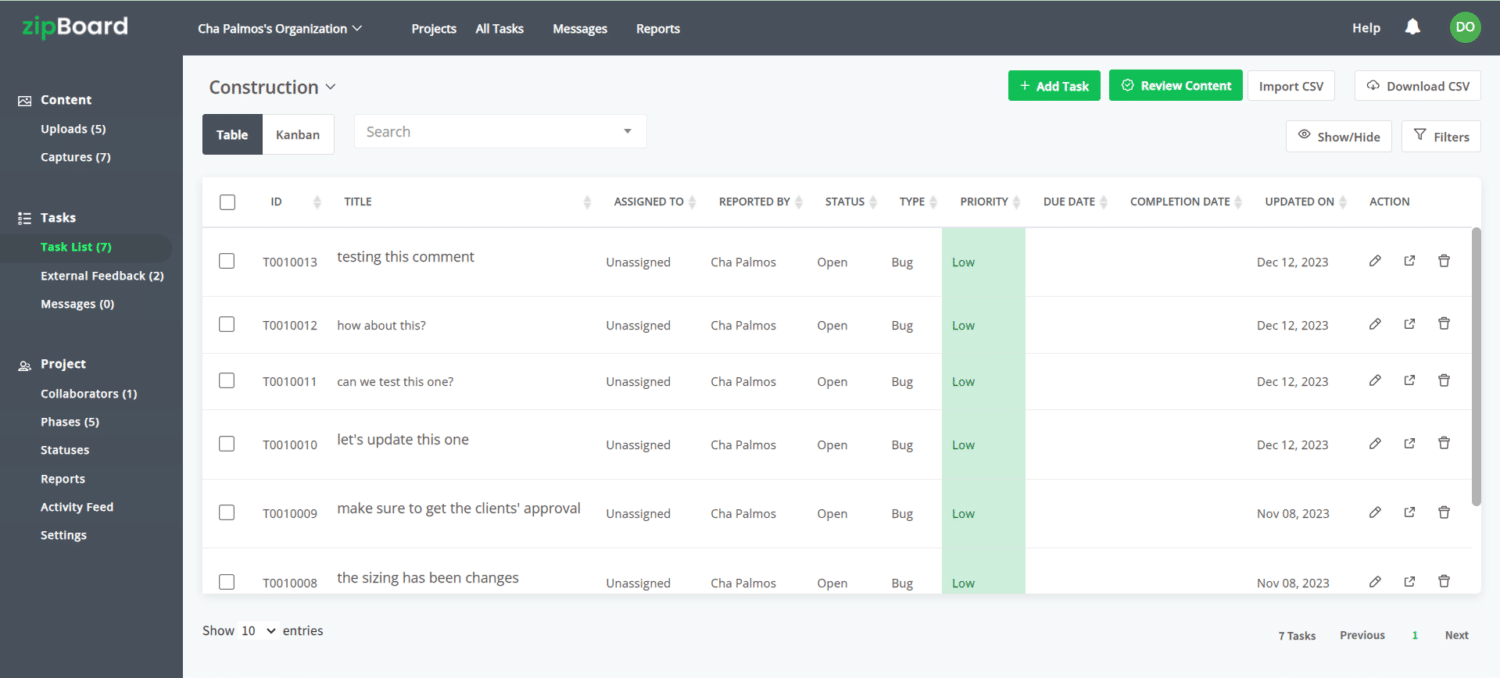
With zipBoard, you can assign tasks, set deadlines, track progress, and even import your existing task list or export what you create in zipBoaed for further customization. This centralized approach promotes accountability, streamlines workflows, and keeps the project moving forward efficiently.
One good thing about zipBoard’s task management system is that annotations and markups collaborators make on documents are automatically converted into tasks and added to the task manager. This helps automate some tasks in your submittal workflow and improves efficiency.
And when it comes to enhancing construction document control, zipBoard makes this easier and seamless by allowing you to organize projects, documents, and tasks using tags. When this is done, you can easily find project information using filters!
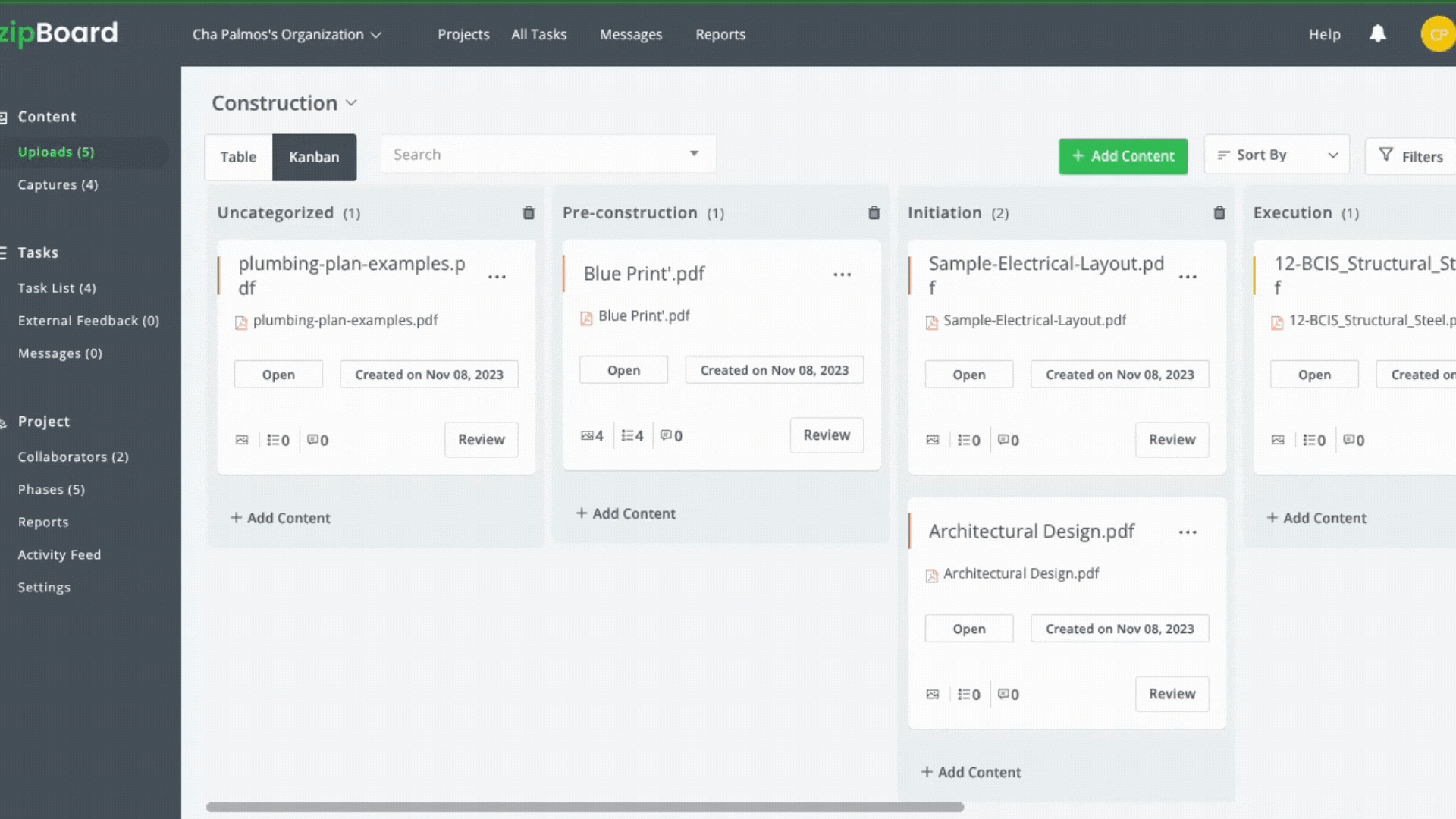
Data-driven Decision-Making with Performance Analysis and Automated Reporting
zipBoard automates report generation, saving architects (read construction administrators) time and ensuring consistent project updates. Stakeholders can receive customizable reports tailored to their needs, keeping everyone informed on project progress and potential issues.
zipBoard’s real-time report dashboards provide a high-level overview of all projects at an organizational level or for specific projects within the organization. This allows CAs to quickly assess project status and make informed decisions.
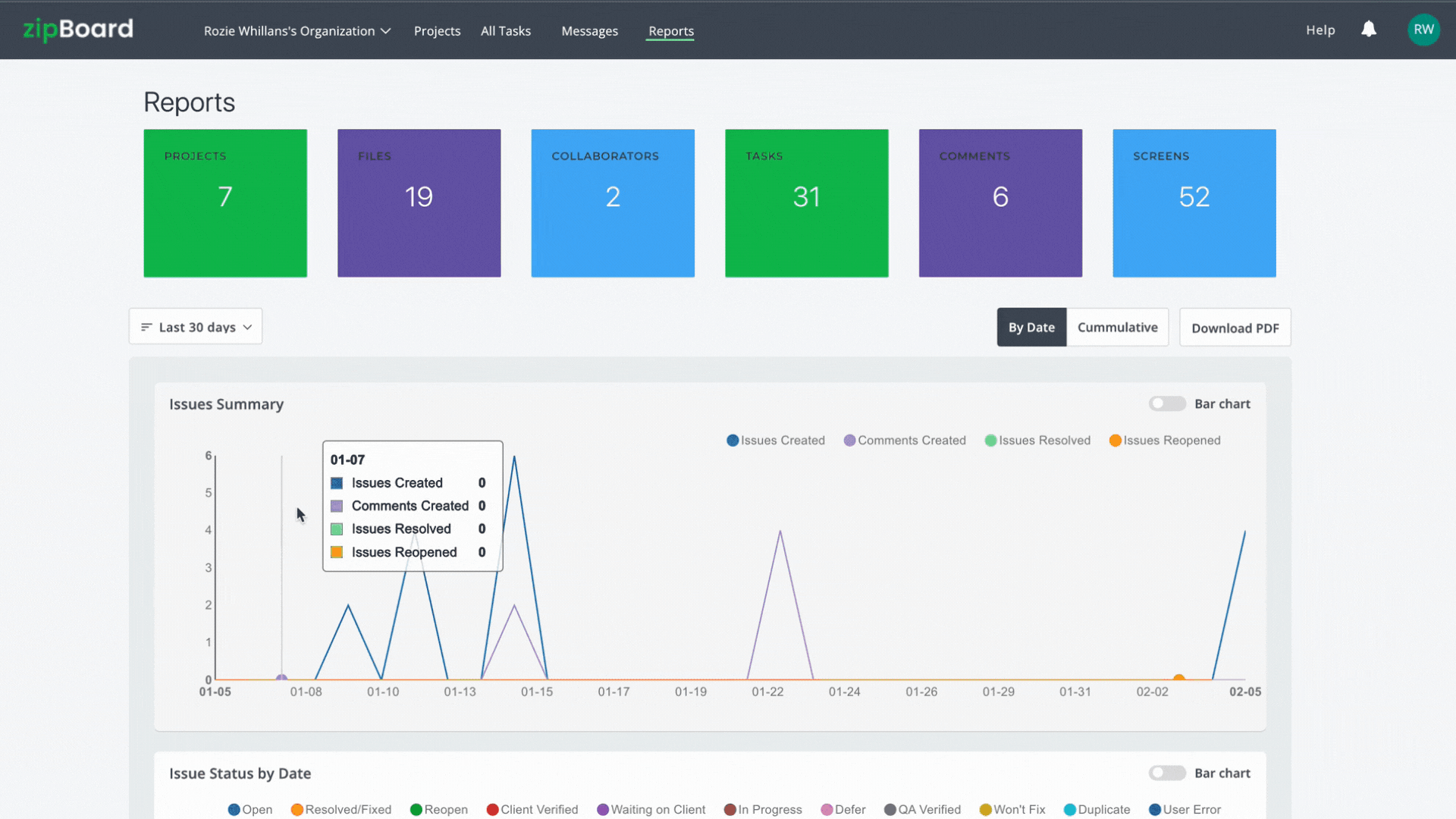
Finally, in the report dashboard, you can view reports for projects, files, collaborators, tasks, comments, and screens. And for each report (displayed in a line graph or bar chart), you have access to issue summaries, status, priority, type, assignees, tags, and stakeholders who report those issues or give feedback. This data enables you to track projects and ensure you’re moving according to schedule.
Want to see this in action? Schedule a demo and we’ll give you a personalized walkthrough.
Step-by-Step Guide to Using zipBoard for Construction Project Collaboration
zipBoard offers an easy-to-use platform for construction project collaboration. Here’s a detailed guide to getting started:
- Sign Up for a Free Trial: Visit the zipBoard website and sign up for a free trial
- Initial Setup: Once you’ve signed up, you’ll receive a welcome email with instructions on how to set up your account. The setup process is simple and can be completed in a few minutes.
- Import Your Documents: Begin by importing your existing documents into zipBoard. Additionally, you can integrate zipBoard with your cloud storage service or ERP system, allowing you to access and collaborate on documents without the need to move or duplicate files.
- Invite Stakeholders: Add your team members to the platform. You can assign roles and permissions to ensure that everyone has the appropriate level of access.
- Annotate and Review Files: Use zipBoard’s collaborative review tools to annotate blueprints, drawings, and site photos. Highlight issues, make comments, and request revisions directly on the files. This ensures clear and actionable feedback for your team.
- Assign and Track Tasks: zipBoard automatically converts annotations and comments form collaborators into actionable tasks in the task list. And you can manually convert feedback from guests if need be. Once done, assign these tasks to specific team members, set priorities, and establish deadlines. Use the Kanban board or Table view to track progress and stay organized.
- Monitor Progress and Status Updates: Use the project dashboard to monitor progress and track overall project health. zipBoard’s automated reporting features provide insights into pending tasks, completed reviews, and project milestones.
- Maintain Document Version Control: Upload new versions of files (in one place) as updates are made. This ensures that your team always works with the latest information and maintains an organized history of changes for reference.
- Share Updates with Stakeholders: zipBoard automatically generates project status reports, which you can download and share progress reports with clients, contractors, and other stakeholders. This transparency builds trust and ensures everyone is informed of the latest developments.
Learn more: Complete Workflow for all zipBoard Users
Streamline Communication & Collaboration in Construction Administration with zipBoard
Start your free trial or book a demo today so that we can create a tailored solution for you.
Book DemoStart Free TrialFAQs
Construction administration is the process of managing and overseeing a construction project to ensure it adheres to the design specifications, budget, and timeline.
It involves coordinating with contractors, subcontractors, and other stakeholders, resolving issues that arise during construction, and ensuring compliance with building codes and safety regulations.
This phase typically begins after the design phase and continues until the project is completed and handed over to the client.
An administrator in construction acts as the central point of communication and coordination among all project stakeholders. Their responsibilities include:
- Monitoring project progress and ensuring it stays on schedule.
- Managing documentation, such as contracts, RFIs, and submittals.
- Addressing and resolving issues or conflicts that arise during the project.
- Ensuring quality control and compliance with design specifications and regulations.
- Facilitating clear communication between the client, contractors, and design teams.
By effectively managing these tasks, a construction administrator helps maintain project efficiency and reduces delays or cost overruns.
The construction administration stage is the phase in a construction project where the design is executed and the actual building process takes place. During this stage, the design team, typically led by the architect or engineer, collaborates with contractors and stakeholders to ensure the project aligns with the approved plans. Key activities during this stage include:
- Conducting site visits to observe progress and address issues.
- Reviewing and approving RFIs, change orders, and submittals.
- Managing documentation and communication between all parties.
- Ensuring compliance with safety, legal, and quality standards.
The construction administration stage bridges the gap between design and completion, ensuring the project’s vision is realized effectively.
Sources
- The Impact of Rework on Construction & Some Practical Remedies by Navigant Construction.
- Construction Disconnected by PlanGrid and FMI.
- VC’s Perspective on How Technology Can Streamline Design Coordination in Construction Projects by Bricks and Bytes.
Author’s bio:
Dorcas Kpabitey is a Content Marketing Specialist at zipBoard. She began her content marketing journey alongside her BA in Political Science and Spanish at the University of Ghana. If she’s not tapping away at her keyboard or spending time on Twitter and LinkedIn, she spends her day reading articles, newsletters and books.
Related Post
Recent Posts
- Why Your Team Needs a Content Feedback System (Not Just Comments in Docs) May 28, 2025
- Content Approvals Are Slowing You Down — Here’s the Fix May 26, 2025
- How to Streamline Content Review and Approval — Best Practices, Tools & Automation May 12, 2025
- What Is Content Operations? And Why It Breaks Without a Feedback & Approval System May 3, 2025
- Why Designers Need a Website Visual Feedback Tool: Improve Design Reviews & Client Collaboration April 25, 2025
©️ Copyright 2023 zipBoard Tech. All rights reserved.
